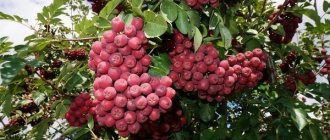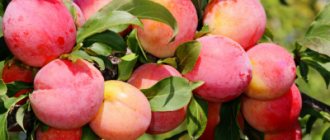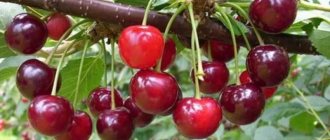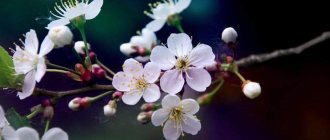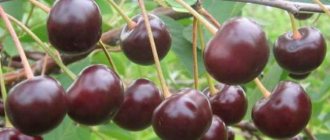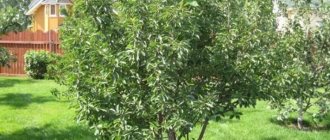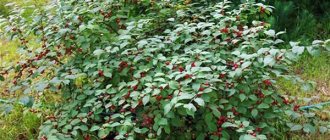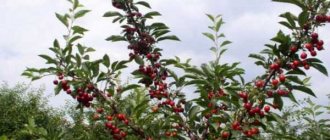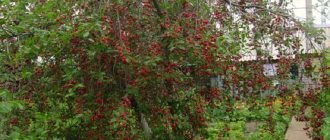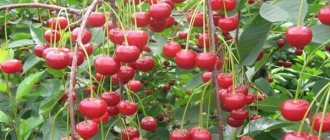Ural Ruby Cherry: description of the variety
Ural Ruby Cherry: photo of the variety
At the moment, of all the existing varieties of cherries, and there are about 15 of them, only 5 are edible: Magaleb, felt, steppe, sweet cherry and ordinary, which is no longer found in nature. The varieties were obtained through selective sampling and cross pollination of wild cherry species. The number of available cultivar varieties is unknown, since fresh ones appear every day, and those that become obsolete are destroyed in a special way. Ural Rubinovaya cherry is one of the oldest varieties and will be in demand among summer residents and gardeners in the north of the country for a long time.
Ural Ruby cherry: history of variety development
Ural Ruby Cherry: photo of the variety
The first representatives of the Ural Rubinovaya cherry variety were bred by S.V. Zhukov and N.I. Gvozdyukova in 1954 at the horticulture station in Sverdlovsk. Cherry passed the state variety test in 1955, and in 1959 it was entered into the State Register.
Ural Ruby Cherry is a mutant cherry for steppe cultivation, created by mixing the Ideal variety and various Michurin varieties. It was created primarily for planting in the climate regime of Siberia and the Urals. Today, the main goal of growing and using the variety is to create new varieties based on the properties of the Ural Ruby, for example, high fertility, tolerance to cold and heat.
Cherry variety Ural Rubinovaya: main characteristics
Ural Ruby Cherry: photo of the variety
The Ural Rubinovaya cherry variety grows in the form of a bush, like other representatives of the steppe cherry. Its height is most often equated to 1.5 m. The crown is spreading, presented in the form of a wide circle, the branches bend low to the ground. Young shoots are most often dirty green, but over time they change color to purple-brown and become bare. The leaves are oval-shaped, with a pointed tip and serrated edges. The leaf is dark green on top and lighter green underneath. Flowers are formed either on the shoots of inflorescences or on annual branches.
For reference! The shoots of inflorescences are branches about 3 cm long, on which up to 10 flower buds are formed.
The fruits of the Ural Rubinovaya cherry variety are round, medium-sized, weighing no more than 3.5 g, dark scarlet in color. This variety is considered a griot, which means that its pulp and nectar have the same color as the berry itself, that is, scarlet. The taste of cherry is sweet and sour, quite pleasant and soft. The bone is small and comes off easily. The stalk is not long, holds tightly to the berry, allowing it to separate only after final ripening.
These cherries can be grown in regions with any type of climate, however, cool climates are most suitable. It can be found in regions such as Western Siberia, the Urals and the Volga-Vyatka region.
There are currently approximately 30 varieties of steppe cherries in the State Register, including the Ural Ruby cherry. Even seventy years after registration in the registry, this variety is still in demand.
Level of susceptibility to frost and drought
The Ural Rubinovaya cherry variety was created primarily for cultivation in harsh weather conditions. We can say that it can adapt to absolutely any climate, including arid ones. The ovaries and shoots are able to tolerate temperatures below -35 degrees. The most important characteristic that helps the plant withstand frost is its size, because this cherry is a shrub, and during winter it is almost completely covered with snow.
Ural Ruby Cherry: pollinators, flowering period and fruit formation
Ural Ruby cherry is a rather late variety, and depending on the habitat and weather, it begins to bloom in late May or early June. But it begins to bear fruit in the middle, sometimes towards the end of August. Due to the fact that the stalk clings tightly to the base of the berry, the fruits will definitely finish flowering completely and will not fall off before the due date.
Since the plant blooms relatively late, this helps to save its components from the late frosts of the northern spring and wait for the arrival of insects that can pollinate the cherry. Pollination is a very important process for the variety, due to the fact that it is self-sterile. The most suitable pollinators are Mayak, Vole, Alatyrskaya, Zagrebenskaya and Shchedraya.
Remarkable! If you want better fertilization, you should plant the plants at a distance of about 40 m from each other.
It is also interesting that the Ural Rubinovaya cherry variety can be grown not only to produce fruits, but also to use it as a pollinator for cherry varieties that bear fruit and bloom late. Pollination by this plant occurs quickly and very efficiently. It can also be used as material for breeding new varieties.
Growing
The process of growing Ruby cherries is simple, but requires knowledge of certain features:
- the optimal soil for rapid establishment of seedlings is loamy, light, fertile;
- lighting and ventilation on all sides of the trees should be maximum;
- Cherry trees are not planted near groundwater (melt) due to rapid death;
- the best time for planting is spring, just before buds open;
- obligatory observance of distances between trees up to 2 m, holes in width - 50-60 cm;
- watering – moderate, to avoid rapid rotting of the root system;
- carrying out preventive pruning twice a year (spring, autumn);
- timely mulching of the soil to prevent the formation of a hard dry crust on the surface;
- spraying seedlings in the autumn when plowing the land;
- application of phosphorus-potassium fertilizers.
Climatic conditions
Winters in the Urals are long and cold, summers are short and dry.
This presents difficulties and limitations for gardeners when cultivating and planting fruit trees. Ruby cherry is a suitable option, since the variety is fast-growing and frost-resistant. It grows in bushes no more than 2 m in height and has a wide crown. Such characteristics make it possible to withstand late or early frosts, as long as the plants are regularly pruned and sprayed. We recommend reading about the Bessey cherry variety here.
The soil
The root system of young ruby cherry seedlings needs fertility. Ideally, plant on light, loose, loamy soil with sufficient breathability.
In order for the root system of seedlings to quickly strengthen and grow, seedlings must be planted away from groundwater to avoid stagnation of water and the development of fungal diseases.
If plants are planted in the fall (at the end of September), then the seedlings need to be planted to a depth of 0.5 m and the soil must be supplied with fertilizers: ash, potassium chloride, superphosphate. If planted on clay soil, then additional river sand should be added to the compost composition.
After planting the seedlings, the soil must be mulched and rotted compost and sawdust added under the trunk.
Landing
Ruby cherry will not grow in the shade, so first of all, before planting, you should pay attention to lighting and ventilation in the area.
Basic landing requirements:
- It is better to plant young seedlings in the spring and place them in the ground until the buds open.
- In order for plants to quickly take root in the ground and begin to grow, they must be planted in 50x50 cm holes, at a distance of 2.5 m from each other, and immediately apply the first fertilizing (superphosphate + potassium chloride).
- A layer of ash is poured into the bottom of each hole; if there is clay soil, sand (1 bucket).
- It is imperative to drive pegs into the planting holes to support fragile bushes.
- Before planting, the roots should be cleaned of dirt and soaked in a bucket of water for 3-4 hours and only then lowered into the ground, lightly compacting the soil.
- Immediately after planting, the seedlings are filled with clean, settled water (at least 2.5 liters of water for each bush).
- It is important to compact the earth around the circumference to avoid leaving voids and water leaking out of the holes, for which you can make a roller up to 60 cm in diameter.
- After planting, the base of the seedlings should be fed with mulch (sawdust, compost).
- When planting in winter, be sure to immediately wrap the root system.
Correct planting of the root collar of the plant will be considered if, after abundant watering and subsidence of the bushes, the root collar is somewhat visible at ground level.
Quantity and quality of fruits produced
The Ural Rubinovaya cherry variety bears fruit steadily from year to year, bringing an excellent harvest. All berries ripen at the same time, and the harvest can be harvested quickly in one go. An adult active shrub, located in conditions favorable for ripening, can bear fruit weighing 10 kg. And in general, there is rarely a harvest weighing less than 6 kg. When grown under industrial conditions, the weight of the harvested fruit reaches 60-90 c/ha from year to year.
The Ural Ruby cherry begins to bear fruit early, about 2-3 years after planting. Cherries bear fruit consistently for 13-15 years. Then the yield begins to decline, however, if the purpose of the berries is to prepare jam and compotes for the family, then the bush will bear fruit for up to 25-30 years.
Options for eating berries
Before planting a variety in your garden, you need to understand that it is agrotechnical. This means that the berries are mainly used for heat treatment, that is, for making jams and other sweets. In other matters, cherries can be consumed raw, but the taste of the berries is inferior to other types, which means it is better to choose them.
The fruits of the Ural Ruby cherry can be collected unripe; they will ripen already during aging. Also, berry sellers should take into account the fact that fruits that are already ripe may crack, which will ruin their appearance.
Purpose
The fruits of the Ural ruby can be considered universal in use. They have a fairly low sugar content, only 8.4-9.6%, while the acid content is quite significant - 1.5-1.9%, so they are consumed much less often fresh than in processed form.
The main advantage of sweet and sour fruits is canning. You can make jams, preserves, and compotes from them. Also, cherry fruits are widely used in cooking. It will be useful to stock up for future use and freeze, dry or wilt berries for the winter.
The plant can be planted as a decorative ornament in the garden. It is widely used in cultivation for beekeeping, as it is an excellent honey plant.
How long do jungarians live and how to help them live longer || How long do Djungarian hamsters live?
Tolerance of diseases and pests
A disease called coccomycosis is a real killer for many varieties of cherries, and at the moment it poses the greatest danger. At the time of the creation of the Ural Rubinova, this disease was not so dangerous, so the creators claim that its tolerance to diseases of this type is rather poor; the risk of getting sick in cherries is quite high.
Pests that can most seriously threaten the plant include the sawfly and cherry aphids. Insects do not often damage this cherry tree, but the bush should be cleaned to avoid trouble.
Pros and cons of the variety
The Ural Rubinovaya cherry variety can be considered one of the best technical varieties of cherries. Its main advantages are:
- The plant begins to bear fruit early; The first fruits can be collected 3 years after planting in the garden.
- The variety bears fruit for a long time, approximately 30 years.
- High tolerance to low temperatures, reaching down to -35 degrees.
- Heat and drought resistance.
- The small size of the bush makes it easier to collect fruits.
- Suitability for growth in cold northern latitudes.
- Good vitamin content of fruits.
- No difficulties in care.
And the disadvantages of the Ural Ruby bush cherry include:
- Late ripening and fruit picking begins towards the end of August, sometimes even towards the beginning of September.
- A small amount of fruit produced.
- The berries are not suitable for fresh consumption; they have a specific taste.
- Obligatory need for pollination.
- Low level of tolerance to coccomycosis and other diseases.
Choosing the right soil
For proper development and active growth, the tree requires suitable fertile soil. Young cherries are planted in a well-ventilated area with plenty of sunlight.
It is important that groundwater is not located close to the root system of the seedling: stagnant moisture can provoke fungal diseases and rot. The substrate for planting must be breathable, light and loose
Loamy soils are best suited for cherries. Planting a young plant usually occurs in the spring, before the buds open. Autumn planting is planned for the end of September, otherwise fragile seedlings may die when the first cold nights arrive.
A hole is dug 0.5 m wide and deep. Fertile soil mixed with superphosphate, ash and potassium chloride is placed at its bottom. For clay soils, it is recommended to add river sand. Before planting, the root system of the plant is soaked in water with root formation stimulants for several hours. If planting in groups, you need to leave a distance of at least 2 m between the plants. A peg is driven into the hole, then the seedling is placed there and the roots are covered with soil. Then the tree trunk circle is compacted, 2-3 buckets of water are poured into it. It is advisable to form an earthen roller around the tree to simplify further maintenance. After planting, the soil is mulched with sawdust and rotted compost.
Landing specifics
Despite the possibility of planting in any region, the most comfortable conditions for the bush are in the northern regions. In the south the variety does quite poorly.
Terrain and seating period
A more suitable period for planting shrubs in the north would be the beginning of spring. The bush should be planted in the garden before flowering begins. There is also the option of planting in the fall, but you need to be prepared for the fact that the cherry may not have time to take root before frost.
The best place for landing is on a sloping hill with good light on the western or northwestern side. Growth in the plains is slow, and in low areas it is at risk of disease and will not bear much fruit.
The soil cannot be oxidized or have fertility; loamy soils are best suited. Groundwater should be 2 m deep from the surface.
Selection and organization of planting resources
It is better to buy bush cherry seedlings Ural Rubinovaya not in stores, but in gardening centers and nurseries. The variety must be suitable for the temperature conditions of the region. To avoid the death of grafted cherries in winter, you need to buy rootstock also for a given region.
Annual plants should be taken with a height of no more than 80 cm, biennial plants - 110 cm. With excessive growth up to 150 cm, nitrogen should be removed from complementary foods. A signal about this can be a change in the color of the bark from brown to green. You also need to monitor the root system of the cherry to maintain its health.
Note! It is better to choose seedlings and shoots with their own roots or with a dormant bud.
Sequence of actions during disembarkation
Bush Ural Ruby cherries should be planted at a distance so that they do not block each other's light. In addition, this will help to avoid widespread infection of cherries with diseases. The best choice of area is 4x2.5x3 m.
The landing algorithm is as follows:
- The roots of the seedlings should be placed in water for approximately 3 hours.
- Next, dig holes 50x50x50 cm, pour a bucket of humus, 50 g of salt and phosphate fertilizers into them.
- If there is an excess of clay, sand should be added to the soil, and acids - lime or special flour.
- The root neck should be 5 cm above the ground when planting.
- Fill the hole with the vitamin mixture, tamping it down.
- It is worth watering with 2-3 buckets per bush.
- It is better to cover the trunk with earth and mulch.
Planting and care
Ural ruby cherries are best planted in a sunny and well-ventilated area of the garden.
First of all, you need to pay attention to the remoteness of groundwater. If they lie close to the surface, you may not expect a harvest from a tree growing in this place
The main soil parameters for good growth and proper development of a cherry tree should be as follows:
- ease;
- good friability;
- fertility.
It is recommended to plant young trees in the spring, before the buds begin to bloom, or in the fall, at the end of September.
Important! Experienced gardeners recommend planting this hybrid in early spring. Since autumn in the Urals can be quite cold, the young tree will not take root well and will simply die with the onset of the first frost
Instructions for planting seedlings
The distance between seedlings should be 2.5-3 meters.
Before planting, it is necessary to prepare a planting hole; its depth should be about 45-50 cm.
The hole must be filled with a fertile layer of soil, which must contain potassium chloride, superphosphate and wood ash. If the soil layer on the plot is clayey, sand must be added to the soil substrate.
A peg at least 1.5 meters long is driven into the prepared moon. It will serve as support for the young tree.
The next step is soaking the roots of the tree in water. It should remain in this state for no more than 2.5 hours. Next, the prepared seedlings are placed in a hole and sprinkled with prepared soil, compacting it well. The planted bush is well shed with water, which must stand for at least a day, at the rate of 3 buckets of water per tree.
The last stage of planting work is mulching the base of the seedling with a mixture of sawdust and compost.
Fertilizing for Ural ruby cherries
Agricultural technology
Proper care of cherries will help you achieve a large harvest of cherries. Like any other plant, a young hybrid needs careful care. At first, it is necessary to organize timely watering of the plant, loosening the soil around it and doing sanitary pruning of the branches. After the roots of the tree grow, mineral fertilizers are applied, which include potassium and phosphorus.
It is necessary to fertilize cherries with organic fertilizers no more than once every three months. Rotted manure or compost is used as organic matter. In the spring, the dose of nitrogen-containing fertilizers is increased.
Important! It is necessary to carry out regular inspection of cherry trees in order to promptly detect pests or diseases
Further care of the plant
The cherry tree should be constantly watered during its 1 year of life in the garden. Afterwards, mulch the area near the trunk and weed. Water only dry bushes. The most important period for watering is fertilization and the formation of ovaries. It is worth stopping watering 2-3 weeks before harvesting the fruits. For a safe winter in the event of a dry autumn, you need to recharge the bush with moisture.
The most important fertilizers are nitrogen and potassium, slightly less phosphorus. Otherwise, you can simply fill in the ash and humus after harvesting. The bush undergoes sanitary pruning to avoid disease, and formative pruning - cutting off too long shoots. It is also worth cutting off dry branches.
Attention! The best time for circumcision is spring.
To protect cherry trunks from rodents, they need to be tied with reeds, straw, burlap and other material with similar properties in the fall, before frost sets in.
Features of seasonal care for cherries
Caring for the “Ural ruby” cherry after planting does not differ from that required for all trees of this type: fertilizing, watering, pruning old branches and loosening the soil if necessary.
Watering and loosening
During the growing season, 3-4 waterings are enough for cherries, which need to be done during the development phases of the tree:
- The tree needs to be watered for the first time after flowering;
- the second watering occurs at the moment of formation of the ovary (after June shedding);
- the third watering should be done after harvesting or in early autumn;
- 4th watering - pre-winter, in mid-October.
The norm for growing season watering for cherries is 5-7 buckets per tree and depends on the age.
Fertilizer application
Fertilizers that contain potassium and phosphorus are applied in the fall so that this process can be dug up. Organic matter (compost or rotted manure) is added every three years. Nitrogen is applied in the spring, directly under the bush of the plant.
In this case, it is necessary to carry out two additional feedings. The first occurs during flowering, the second - 14 days after its end, mullein and ash are used for this.
Disease and pest control
"Uralskaya Rrubinovaya" perfectly resists cherry aphids and slimy sawfly, but can suffer from a fungal disease - coccomycosis. We can talk about infection with fungal spores if brown spots on the leaves are found on the tree, and their sudden shedding is noticed, which occurred much earlier than expected.
This is very dangerous for the tree, since the bare plant is deprived of the opportunity to feed normally. As a result, it quickly weakens, which over time can lead to its death. To prevent this from happening, the tree must be treated with fungicides (Copper sulfate, Topaz, Rayok, Horus, Abiga-Peak).
Pruning and crown formation
It is advisable to prune the tree before the first buds appear on it, so that the plant has time to get stronger during the period of active growth and flowering.
After planting the seedling, you need to leave about 10 of the most developed and strong branches on it (about 5 branches are left for trees). The remaining branches are pruned without leaving a stump, and the pruning area must be immediately lubricated with garden varnish.
The branches that remain after pruning should face in different directions and be at a distance of 10 cm from each other.
The main rules for pruning young cherries:
- in the second year, the branches growing inside the crown are pruned, and the shoots formed on the trunk are broken off in the summer (while they are green). This will help prevent thickening of the bush;
- it is necessary to shorten shoots that have grown over half a meter in length;
- During the growth of the cherry, new skeletal branches must be left on the trunk. This will help to form the crown correctly. As a result, there will be 12-15 main branches;
- dry and diseased branches should be removed annually.
Pruning the crown and cutting off unnecessary branches is useful in several cases:
- correct formation of the tree, so that it will not be one-sided with a thickened crown;
- the harvest will increase significantly;
- the berries will be larger and more pleasant to taste;
- removing old and diseased branches protects the plant from pests;
- After pruning, the tree becomes younger and ages longer.
Protection from cold and rodents
To protect cherries from early frosts, you need to use smoke: early in the morning when frost begins in the garden, you need to set fire to piles of straw, hay or other similar materials. At the same time, they should be slightly damp so that there is no fire, but a lot of smoke.
Another way to protect a tree is to delay its flowering time. This will reduce the chance of falling under return frosts. To do this, you need to compact the snow tightly around the cherry, and then cover it with a large layer of straw or hay.
You can protect cherries from rodents using wood ash, peat chips or sawdust soaked in creolin or kerosene. This all repels rodents. In addition, cats and hedgehogs are good helpers in the fight against them.
Rodents don't like certain smells. Therefore, some gardeners advise spraying trees with mint solution or coating them with fragrant lard or tar.
"Ural ruby" is used as a fruit crop. Reviews from gardeners about this cherry variety are only the most positive. It is especially valuable because of its frost resistance, rich harvest and resistance to many fungal diseases. Its disadvantages are: self-sterility and average-tasting fruits.
Diseases and parasites
Most often, the plant is damaged not by parasites, but by various fungal diseases. To combat this, after the end of flowering, cherries are sprayed with a medicine containing copper, and in the fall with iron sulfate. When pests appear, the bush must be treated with insecticides every 2 weeks. Ural Rubinovaya is an excellent technical variety that is best grown in northern climates. With proper care and treatment against viruses, it will give a good harvest and help with pollination of other varieties.
